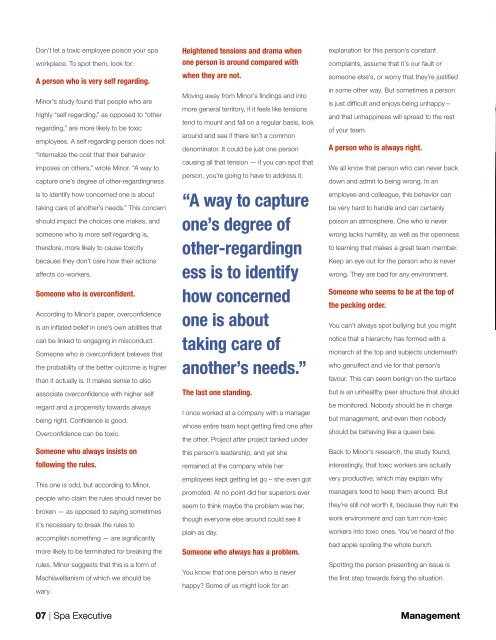Create successful ePaper yourself
Turn your PDF publications into a flip-book with our unique Google optimized e-Paper software.
Don’t let a toxic employee poison your spa<br />
workplace. To spot them, look for:<br />
A person who is very self regarding.<br />
Minor’s study found that people who are<br />
highly “self regarding,” as opposed to “other<br />
regarding,” are more likely to be toxic<br />
employees. A self regarding person does not<br />
“internalize the cost that their behavior<br />
imposes on others,” wrote Minor. “A way to<br />
capture one’s degree of other-regardingness<br />
is to identify how concerned one is about<br />
taking care of another’s needs.” This concern<br />
should impact the choices one makes, and<br />
someone who is more self regarding is,<br />
therefore, more likely to cause toxicity<br />
because they don’t care how their actions<br />
affects co-workers.<br />
Someone who is overconfident.<br />
According to Minor’s paper, overconfidence<br />
is an inflated belief in one’s own abilities that<br />
can be linked to engaging in misconduct.<br />
Someone who is overconfident believes that<br />
the probability of the better outcome is higher<br />
than it actually is. It makes sense to also<br />
associate overconfidence with higher self<br />
regard and a propensity towards always<br />
being right. Confidence is good.<br />
Overconfidence can be toxic.<br />
Someone who always insists on<br />
following the rules.<br />
This one is odd, but according to Minor,<br />
people who claim the rules should never be<br />
broken — as opposed to saying sometimes<br />
it’s necessary to break the rules to<br />
accomplish something — are significantly<br />
more likely to be terminated for breaking the<br />
rules. Minor suggests that this is a form of<br />
Machiavellianism of which we should be<br />
wary.<br />
Heightened tensions and drama when<br />
one person is around compared with<br />
when they are not.<br />
Moving away from Minor’s findings and into<br />
more general territory, if it feels like tensions<br />
tend to mount and fall on a regular basis, look<br />
around and see if there isn’t a common<br />
denominator. It could be just one person<br />
causing all that tension — if you can spot that<br />
person, you’re going to have to address it.<br />
“A way to capture<br />
one’s degree of<br />
other-regardingn<br />
ess is to identify<br />
how concerned<br />
one is about<br />
taking care of<br />
another’s needs.”<br />
The last one standing.<br />
I once worked at a company with a manager<br />
whose entire team kept getting fired one after<br />
the other. Project after project tanked under<br />
this person’s leadership, and yet she<br />
remained at the company while her<br />
employees kept getting let go – she even got<br />
promoted. At no point did her superiors ever<br />
seem to think maybe the problem was her,<br />
though everyone else around could see it<br />
plain as day.<br />
Someone who always has a problem.<br />
You know that one person who is never<br />
happy? Some of us might look for an<br />
explanation for this person’s constant<br />
complaints, assume that it’s our fault or<br />
someone else’s, or worry that they’re justified<br />
in some other way. But sometimes a person<br />
is just difficult and enjoys being unhappy –<br />
and that unhappiness will spread to the rest<br />
of your team.<br />
A person who is always right.<br />
We all know that person who can never back<br />
down and admit to being wrong. In an<br />
employee and colleague, this behavior can<br />
be very hard to handle and can certainly<br />
poison an atmosphere. One who is never<br />
wrong lacks humility, as well as the openness<br />
to learning that makes a great team member.<br />
Keep an eye out for the person who is never<br />
wrong. They are bad for any environment.<br />
Someone who seems to be at the top of<br />
the pecking order.<br />
You can’t always spot bullying but you might<br />
notice that a hierarchy has formed with a<br />
monarch at the top and subjects underneath<br />
who genuflect and vie for that person’s<br />
favour. This can seem benign on the surface<br />
but is an unhealthy peer structure that should<br />
be monitored. Nobody should be in charge<br />
but management, and even then nobody<br />
should be behaving like a queen bee.<br />
Back to Minor’s research, the study found,<br />
interestingly, that toxic workers are actually<br />
very productive, which may explain why<br />
managers tend to keep them around. But<br />
they’re still not worth it, because they ruin the<br />
work environment and can turn non-toxic<br />
workers into toxic ones. You’ve heard of the<br />
bad apple spoiling the whole bunch.<br />
Spotting the person presenting an issue is<br />
the first step towards fixing the situation.<br />
07 | <strong>Spa</strong> <strong>Executive</strong> Management


















